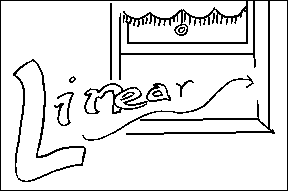



At any moment in our lives our senses are registering many perceptions. You may enter a room with an open window, through which you can see a garden where plants are swaying in the wind. We perceive all the parts of the scene simultaneously, but to describe it in words we have to construct a linear sequence that describes the various aspects one by one.

This process mirrors the way in which our attention moves from one perception to another in a time sequence. However, the movement of the ‘conscious point’ of our perception, is not the same as our perception, which is total and simultaneous.
‘Linearity’ is another practical simplification of language. To describe a scene using language, we describe elements in a time sequence. In the process we tend to include many pre-supposed notions of causality and relative significance.
The choices we make in constructing a linear description are influenced by our perceptual biases. An architect walking into a room may notice the ceiling height and the architraves; a cleaner may notice litter on the carpet or dust on the surfaces; an antique dealer may notice a victorian sideboared or an art deco lamp. (See article on ‘Subjectivity’.)
Once the description is committed to writing, the moment has passed, and we have no way of extracting fact from bias. What may have been an error of perception is forever recorded as history.
* * * * *
Limiting Factors of language
| Language Logic | |
| Basic | |
|
Objectification Linearity (this page) Abstraction Subjectivity |
|
| Composite | |
| Location | |